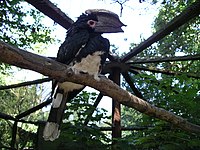Trumpeter Hornbill
| Trumpeter Hornbill | |
|---|---|
 | |
| Conservation status | |
 Least Concern (IUCN 3.1) | |
| Scientific classification | |
| Kingdom: | Animalia |
| Phylum: | Chordata |
| Class: | Aves |
| Order: | Coraciiformes |
| Family: | Bucerotidae |
| Subfamily: | Bucerotinae |
| Genus: | Bycanistes |
| Species: | B. bucinator |
| Binomial name | |
| Bycanistes bucinator (Temminck, 1824) | |
| Synonyms | |
Ceratogymna bucinator
| |
The Trumpeter Hornbill, Bycanistes bucinator, is a medium-sized hornbill, with length between 58 and 65 cm (23 and 26 in), characterized by a large grey casque on the bill, smaller in females. The eyes are brown or red, with pink surrounding skin. Body mass is reported between 0.45 and 1 kg (0.99 and 2.2 lb).They are similar to Silvery-cheeked Hornbill. Distinguishing features include an all-black back, white belly and white underwing coverts (in flight, wings present white tips), and red facial skin.
The Trumpeter Hornbill is a gregarious bird, usually living in groups of 2 to 5 individuals, although sometimes as many as 50. This hornbill is a locally common resident of the tropical evergreen forests of Burundi, Mozambique, Botswana, Congo, Kenya, the Caprivi strip of Namibia and eastern South Africa, where it feeds on fruits and large insects. Like other hornbills, the females incubate 4 to 5 white eggs, while sealed in the nest compartment.
Aviculture
When and fed in captivity they are tame loving birds that can be taught a variety of tricks, and enjoy companionship with their owner. They require large spacious cages to move about in because of their active nature. Care needs to be taken in their high fruit diet because of their susceptibility to excessive iron storage, which is similar to the excessive iron storage seen in the disease hemochromatosis in humans. They are very intelligent and have a life expectancy of up to 20 years.
Widespread throughout its large range, the Trumpeter Hornbill is evaluated as Least Concern on the IUCN Red List of Threatened Species.




No comments:
Post a Comment